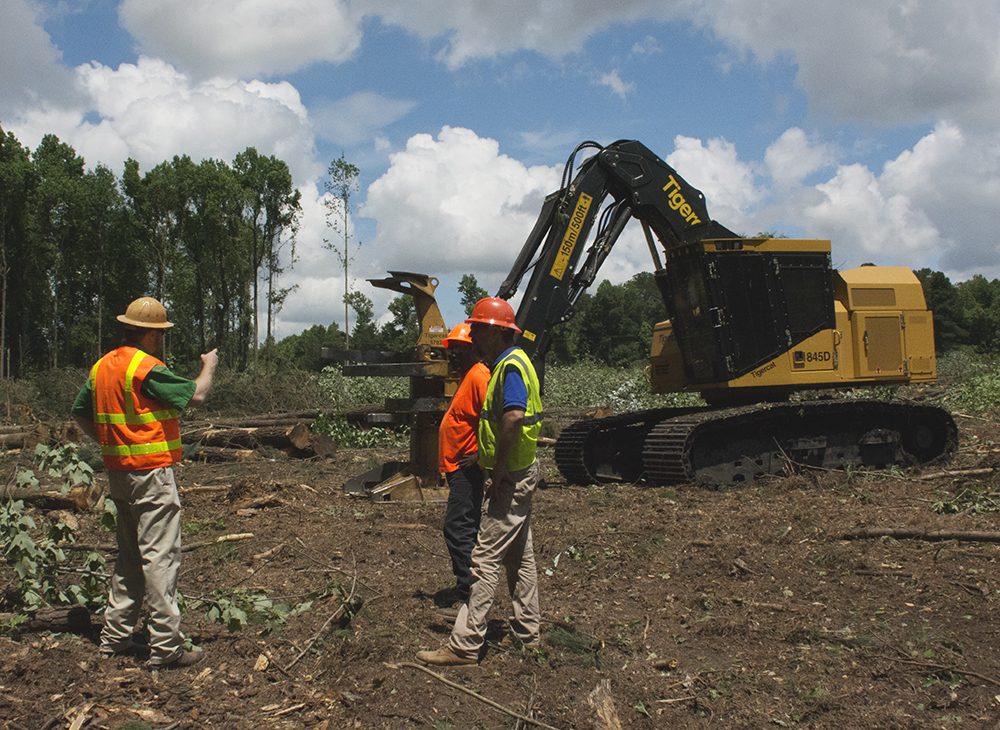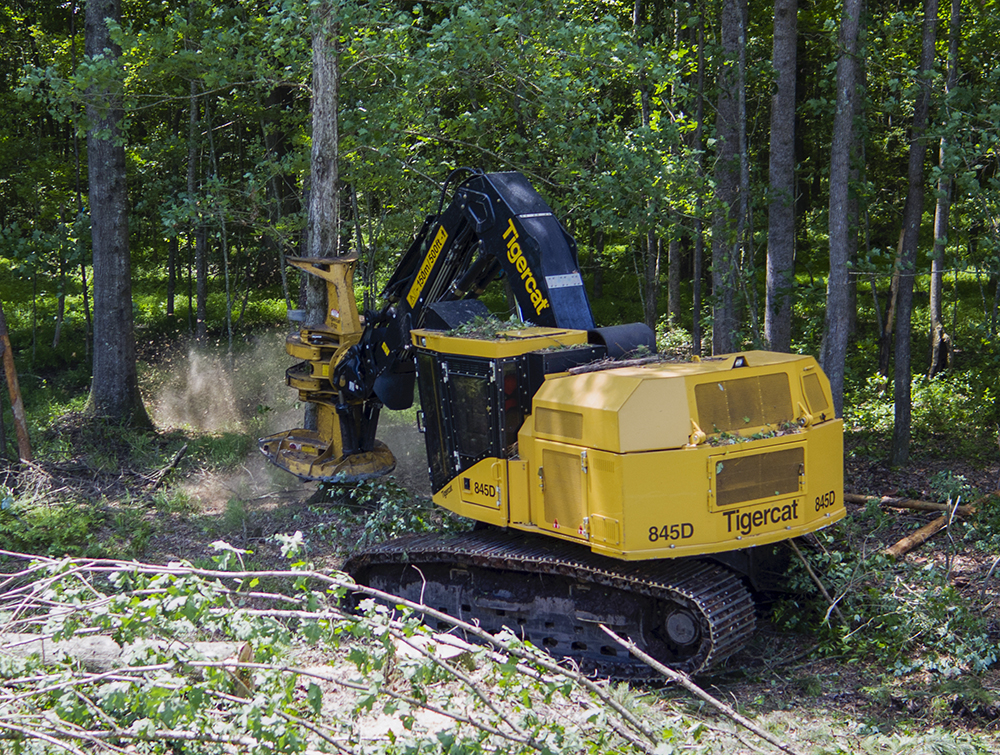Related Content
My Tigercat Circus
01 August 2015
C.K. Greene has made his mark in the Virginia logging industry and stays humble through all his recent growth and success.
31st July 2016
By the name alone, Forrest York was destined for the woods. Recently switching to Tigercat equipment within the last year, Forrest talks to BTB about how he got into logging and how Tigercat now plays a key role in his bottom line business.
– Samantha Paul, Tigercat marketing
49-year-old Forrest York is the owner of Conetoe Land & Timber, LLC based in Goldsboro, North Carolina. Like many forestry professionals, Forrest has a passion for the outdoors. “I love hunting and fishing, I am an outdoors guy,” he says. Unlike many loggers in the southeastern United States, Forrest is a first generation logger, and started his business all on his own.

(L-R) Ben Twiddy, co-owner of Tigercat dealer CTW Equipment, 845D operator Swindle White and Conetoe Land & Timber owner, Forrest York.
Forrest always loved math, science and being outdoors. After realizing engineering school wasn’t for him, he set out to get his Bachelor of Science Degree in Forestry. Forrest got a first taste for how to make a living in the woods when completing a co-op term with a consulting forester, while attending North Carolina State University. “I got on-the-ground experience,” says Forrest. “And I really liked it. It was my calling.”
Out of college, Mr. York started out as a forester and has been working at it for fifteen years. “It is hard to teach people to buy timber. You got to be able to talk to people and negotiate. You have to have a certain demeanor and it’s not easy.”

“There’s nothing we need to do with it that it can’t do,” says 845D operator Swindle White.
As stumpage prices got higher and higher, profi t margins shrunk and logging costs continued to increase, Forrest had to make a difficult decision as to whether or not to bring everything in house. He explains the rationale. “If you don’t make money on the stumpage, then you can make money on the logging… hopefully. It is a huge capital cost but then you are covered from both sides.”
With the help and advice from Ben Twiddy and Wayne Cale, owners of Tigercat dealer CTW Equipment, Forrest started the logging side of Conetoe Land & Timber three years ago. “There is definitely a learning curve. CTW has been very patient with us and have taught us a lot,” says Forrest.
“I own a logging crew, but I am not a logger. I can run the system and market the company but I cannot run those machines,” he says. Many people confuse the role of the forester with that of the logger, but most foresters are concerned not only with the harvest of timber, but also with the sustainable management of forests. In the words of American forester and politician, Gifford Pinchot, “[to] provide the greatest good for the greatest number in the long term.”
Forrest started off his logging crew in 2013 with two new John Deere pieces but has since been transitioning to Tigercat. He prefers working wildlife management properties over clear fell tracts so he knew he needed a track machine that was agile, capable of selective felling and able to get into some tight places.
The numbers are all that matters, and the only way the numbers work is because of those Tigercat machines.
– Forrest York, Conetoe Land & Timber, LLC
To that end, he now has a Tigercat 845D track feller buncher with a 5702 felling saw, a new 630E skidder and a used 718 drive-to-tree feller buncher. “Ya’ll make the best machines and I am not just saying that. It is the truth. I have been logging for three years but that is long enough to realize that. It doesn’t take long,” says Forrest.
Conetoe Land & Timber moves approximately 60 to 70 loads per week with an average tree size of about 14 in (35 cm) in diameter. The company is typically cutting 30 to 60-year-old timber.
One man can’t make a logging job. It takes a team, from the office to the ground operations. Forrest’s wife Angie does all the bookkeeping and takes care of their three young children – one-year-old Colton, three-year-old Ben and four-year-old Ruth. Angie is tough and the backbone of the company. “You have to log to make profit. It is all about the money,” says Forrest. Angie has a profit spreadsheet that she plugs every expense into, down to a tube of grease. This allows them to easily see the big picture and tell if they are making money or losing money. “You have to constantly monitor the bottom line,” says Forrest.

Ben Twiddy, co-owner of Tigercat dealer CTW Equipment, and Forrest York have known each other for over a decade. “CTW parts and service is second to none,” says Forrest.
“The number one thing about Tigercat is dependability and value. It really holds its value,” says Forrest. “I run other equipment. They are not nearly as tough and they do not hold their value.” While Forrest figured that any Tigercat machine would be a good machine, he needed the right feller buncher for his applications. He wanted something that was agile, fuel efficient, easy to move around the woods for selective cuts and easy to move on the highway.
In Conetoe’s applications – flat ground with small to medium sized pine trees – the 845D uses 7 US gph (26,5 L/h) of fuel. Forrest’s previous wheel feller buncher was consuming approximately 5.5 US gph (21 L/h). However, the 845D track machine is significantly faster and more agile so the operator can cut twice as much as he did with the wheeled machine.
After demoing the 845D for about a week and taking into consideration the fuel economy, Forrest made his decision. Operator Swindle White was pleasantly surprised at how strong it was, commenting, “There’s nothing we need to do with it that it can’t do.”
“All we log is the bottom line, that is the most important part. You have to think about the cost per ton,” says Forrest. “The numbers are all that matters, and the only way the numbers work is because of those Tigercat machines. Less downtime, less maintenance and they bring more wood in less trips. That is what makes the numbers work.”
01 August 2015
C.K. Greene has made his mark in the Virginia logging industry and stays humble through all his recent growth and success.